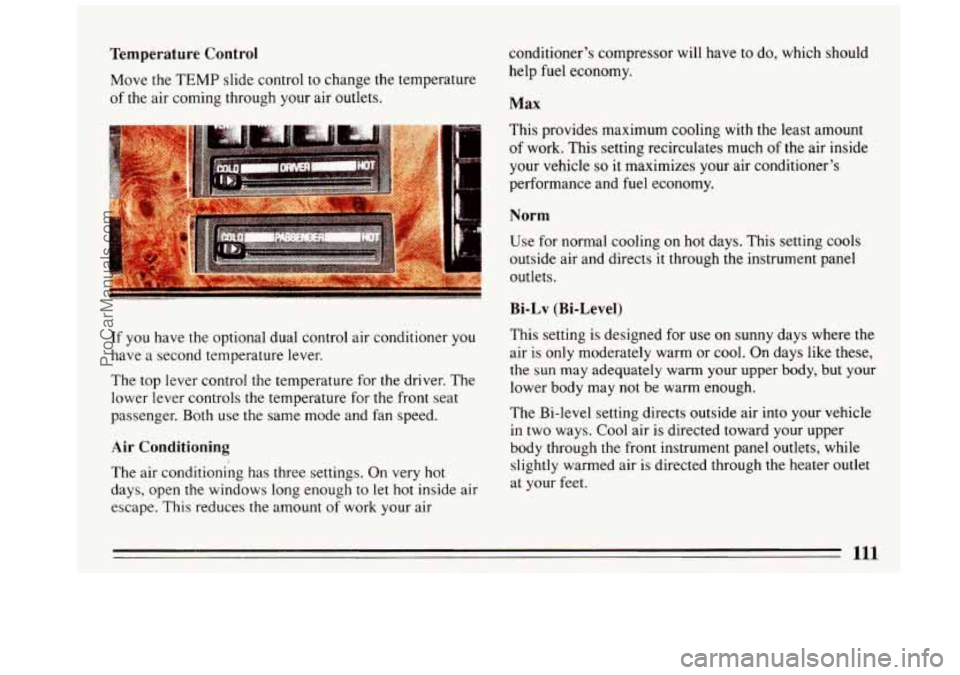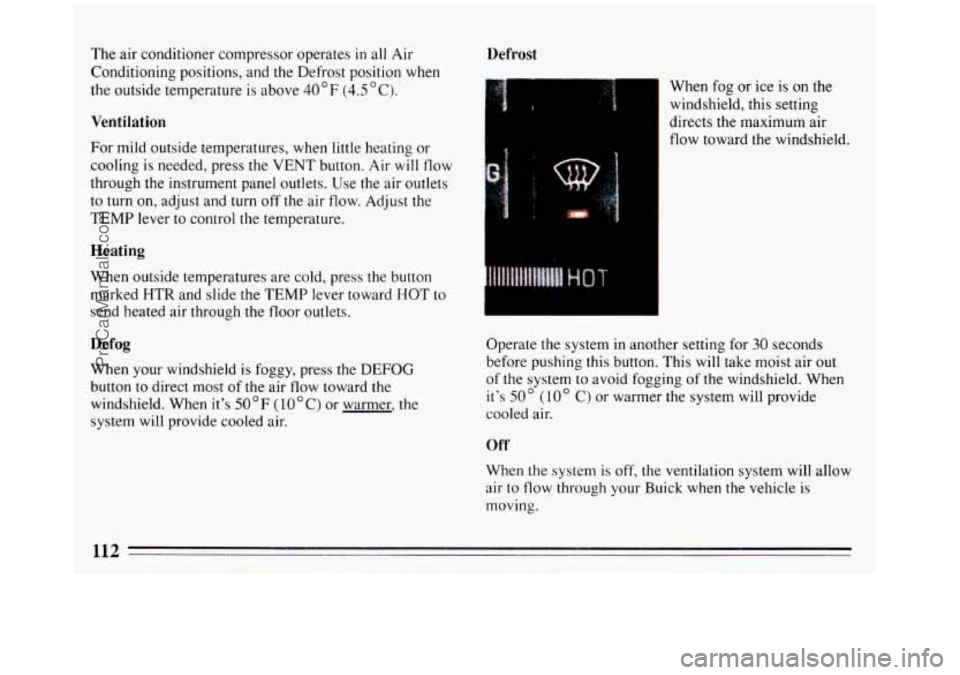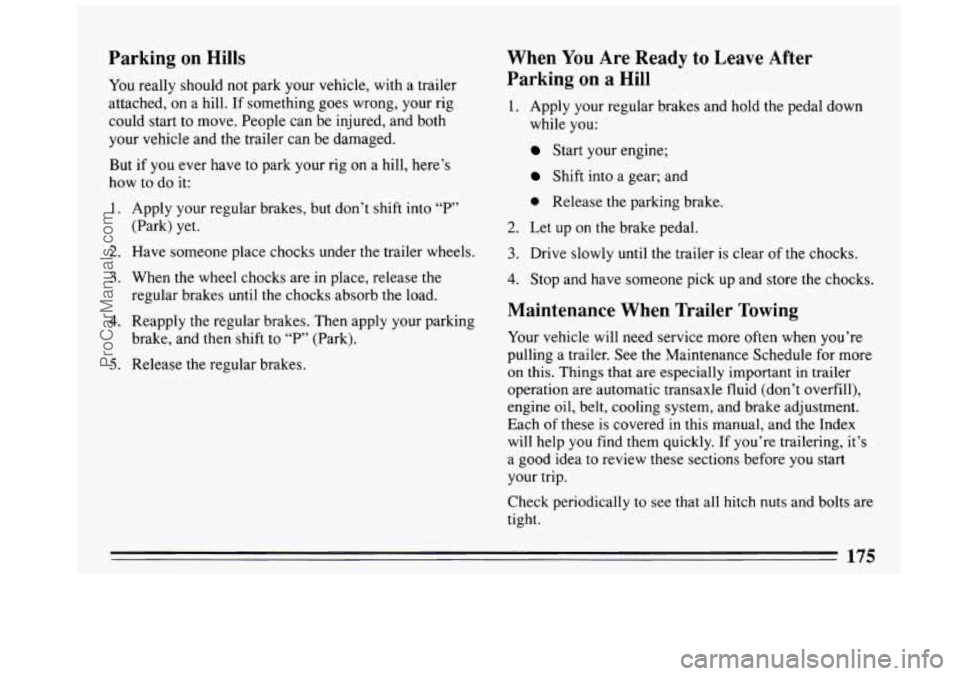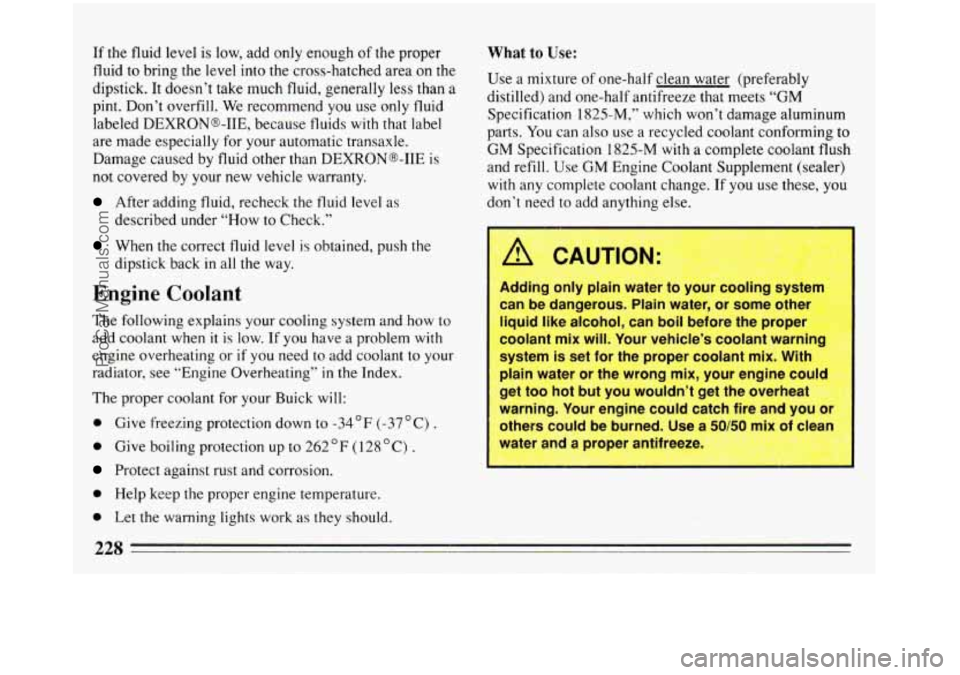Page 113 of 308

Temperature Control
Move the TEMP slide control to change the temperature
of the air coming through your air outlets. conditioner’s
compressor will have to do, which should
help fuel economy. Max
This provides maximum cooling with the least amount
of work. This setting recirculates much of the air inside
your vehicle
so it maximizes your air conditioner’s
performance and fuel economy.
Norm
Use for normal cooling on hot days. This setting cools
outside air and directs it through the instrument panel
outlets.
Bi-Lv (Bi-Level)
If you have the optional dual control air conditioner you
have a second temperature lever.
The top lever control the temperature for the driver. The
lower lever controls the temperature for the front seat
passenger. Both use
the same mode and fan speed.
Air Conditioning
The air conditioning has three settings. On very hot
days, open
the windows long enough to let hot inside air
escape.. This reduces the amount of work your air This setting
is designed for
use on sunny days where the
air is only moderately warm or cool. On days like these,
the
sun may adequately warm your upper body, but your
lower body may not be warm enough.
The Bi-level setting directs outside air into your vehicle
in two ways.
Cool air is directed toward your upper
body through the front instrument panel outlets, while
slightly warmed air is directed through the heater outlet
at your feet.
111
ProCarManuals.com
Page 114 of 308

The air conditioner compressor operates in all Air
Conditioning positions, and
the Defrost position when
the outside temperature is above 40'F (4.5 "C).
Ventilation
For mild outside temperatures, when little heating or
cooling
is needed, press the VENT button. Air will flow
through the instrument panel outlets. Use the air outlets
to turn on, adjust and turn
off the air flow. Adjust the
TEMP lever to control the temperature.
Heating
When outside temperatures are cold, press the button
marked HTR and slide the
TEMP lever toward HOT to
send heated air through the floor outlets.
Defog
When your windshield is foggy, press the DEFOG
button to direct most of the air flow toward the
windshield. When it's
50 F ( 10 C) or warmer, the
system will provide cooled air.
Defrost
When fog or ice is on the
windshield, this setting
directs the maximum air
flow toward the windshield.
Operate the system
in another setting for 30 seconds
before pushing this button.
This will take moist air out
of the system
to avoid fogging of the windshield. When
it's
50' (10" C) or warmer the system will provide
cooled air.
Off
When the system is off, the ventilation system will allow
air to flow through your Buick when the vehicle is
moving.
112
ProCarManuals.com
Page 177 of 308

Parking on Hills
You really should not park your vehicle, with a trailer
attached, on a hill. If something goes wrong, your rig
could start to move. People can be injured, and both
your vehicle and the trailer can be damaged.
But if
you ever have to park your rig on a hill, here’s
how to do it:
1.
2.
3.
4.
5.
Apply your regular brakes, but don’t shift into “P’
(Park) yet.
Have someone place chocks under the trailer wheels.
When the wheel chocks are in place, release the
regular brakes until the chocks absorb the load.
Reapply the regular brakes. Then apply your parking
brake, and then shift to “P” (Park).
Release the regular brakes.
When You Are Ready to Leave After
Parking on
a Hill
1. Apply your regular brakes and hold the pedal down
while you:
Start your engine;
Shift into a gear; and
0 Release the parking brake.
2. Let up on the brake pedal.
3. Drive slowly until the trailer is clear of the chocks.
4. Stop and have someone pick up and store the chocks.
Maintenance When Trailer Towing
Your vehicle will need service more often when you’re
pulling a trailer. See the Maintenance Schedule for more
on this. Things that are especially important in trailer
operation are automatic transaxle fluid (don’t overfill),
engine oil, belt, cooling system, and brake adjustment.
Each
of these is covered in this manual, and the Index
will help you find them quickly. If you’re trailering, it’s
a good idea to review these sections before
you start
your trip.
Check periodically to see that all hitch nuts and bolts are
tight.
175
ProCarManuals.com
Page 196 of 308
tder the hood can =&drt up even
is not running and can injure
--, clothing and tools away frnm
I nlcwtric fan-
~ ~~~~ ---
If the coolant inside the coolant recovery tank is boiling,
don’t do anything else until it
cools down. The
coolant level should be at or above the
“COLD”. If
it isn’t, you may have a leak in the radiator hoses, heater
hoses, radiator, water pump or somewhere else
in the
cooling system.
9
Heater and radiator hoses, and other englne
parts, can be very hot.
do, you can be burned.
Don’t run the engine
if there is a leak. If you r,,,
the engine, it could lose all coolant. That could
cause an engine fire, and you could be burned
my leak fixed before you drive +he vehicl,.
I U
If there seems to be no leak, check to see if the electric
engine fan
is running. If the engine is overheating, the
fan should be running.
If it isn’t, your vehicle needs
service.
194
ProCarManuals.com
Page 198 of 308
Youlean be burned if you spill coolant on hot
engine parts. Coolant contains ethylene glycol
-d it wiil burn if the engine parts are hot
ough. Don't spill
coolant -on a hot engine.
,- '
.Steam and scalding liquids- from a hot 'bootin!,
system can btow o.ut and burn you badly. They
are under pressure,..and.
if you turn the. radiatr-
pre,ssure cap
- even a little - they can come brl
cooling system, including the, radiator pressye
When the coolant in the coolant recovery tank is at or cap, is hot. Wait for the cooling system'and
above "COLD," start your vehicle. radiator pressure cap to cool if:you-ever have to
If the overheat warning continues, there's one more -turn the pressure cap.
thing you can try. You can add the proper coolant mix 3
directly to the radiator, but be sure the cooling system is
cool before you do it.
- at high speed. Never turn,the cap'when the+;:.::
-, .I
I
196
ProCarManuals.com
Page 199 of 308
x 8
ir
..-,
How to Add Coolant to the Radiator
7 1. You can remove the
radiator pressure
cap when
the
cooling system,
including the
radiator pressure
cap and upper
radiator hose, is
no
longer hot.
Turn the pressure cap slowly to the left until it first
stops. (Don't press down while turning the pressure
If you heal- a hiss, wait for that to stop. A hiss means
there
is still some pressure left.
cap.)
197
ProCarManuals.com
Page 230 of 308

If the fluid level is low, add only enough of the proper
fluid to bring the level into the cross-hatched area on the
dipstick. It doesn’t take much fluid, generally less than a
pint. Don’t overfill. We recommend you use only fluid
labeled DEXRONB-IIE, because fluids with that label
are made especially for your automatic transaxle.
Damage caused by fluid other than DEXRONB-IIE is
not covered by your new vehicle warranty.
After adding fluid, recheck the fluid level as
described under “How
to Check.”
When the correct fluid level is obtained, push the
dipstick back in all the way.
Engine Coolant
The following explains your cooling system and how to
add coolant when
it is low. If you have a problem with
engine overheat.ing or if you need to add coolant to your
radiator, see “Engine Overheating”
in the Index.
The proper coolant for your Buick will:
0 Give freezing protection down to -34OF (-37OC) .
0 Give boiling protection up to 262 OF (128 “C) .
Protect against rust and corrosion.
0 Help keep the proper engine temperature.
0 Let the warning lights work as they should.
What to Use:
Use a mixture of one-half clean water (preferably
distilled) and one-half antifreeze that meets
“GM
Specification 1825-M,” which won’t damage aluminum
parts. You can also use a recycled coolant conforming to
GM Specification 1825-M with a complete coolant flush
and refill. Use GM Engine Coolant Supplement (sealer)
with any complete coolant change. If you use these, you
don’t need to add anything else.
can be aangerous. Plain water, or some other
liquid like alcohol, can boil before the proper
coolant mix will. Your vehicle’s coolant warning
system is set for the proper coolant mix. With
plain water or the wrong mix, your engine could
get too hot but you wouldn’t get the overhe-”
warning. Your engine could catch fire and
yuu or
others could be burned. Use a 50/50 mix of clean
water and a proper antifreeze.
G:~Z.+T~:, p:.t+d+s
228
ProCarManuals.com
Page 261 of 308
10
10
15
10
Electrical Center
Passenger Side - Underhood
Amp Description
18. 20 Fuel Injectors (3.8L)
19.
15 Trunk Release
20. 20 ECM; Fuel Pump
21. 10 ECM (3.8L)
22. 3
Cooling Fan Relay (3.8L)
23. Not Used
24. Direct Ignition System
25. Fuel Injectors (3.1 L)
26. Not Used
27. Ignition
28. TCC; Primary Cooling Fan (3.1 L)
Relay
29.
30.
31.
32.
33.
Fusible Elements
34. 60 Starter Solenoid
35. 60 Cooling Fan
37. 60 Cooling Fan
36. 60 Blower Motor
38. 30 Fuse Block Fuel Pump
Cooling Fan Control
(3.8L)
Secondary Cooling Fan
Primary Cooling Fan
A/C Clutch Coil
This electrical center is also under the hood on the
passenger side.
259
ProCarManuals.com